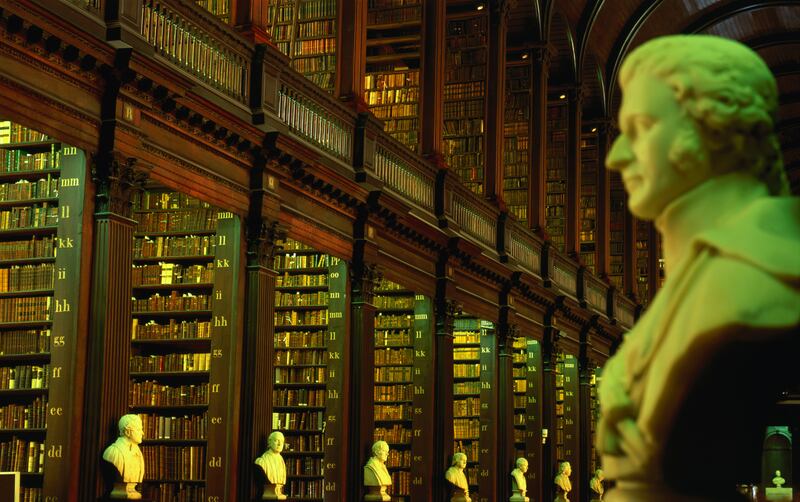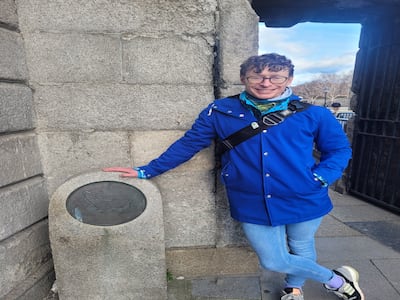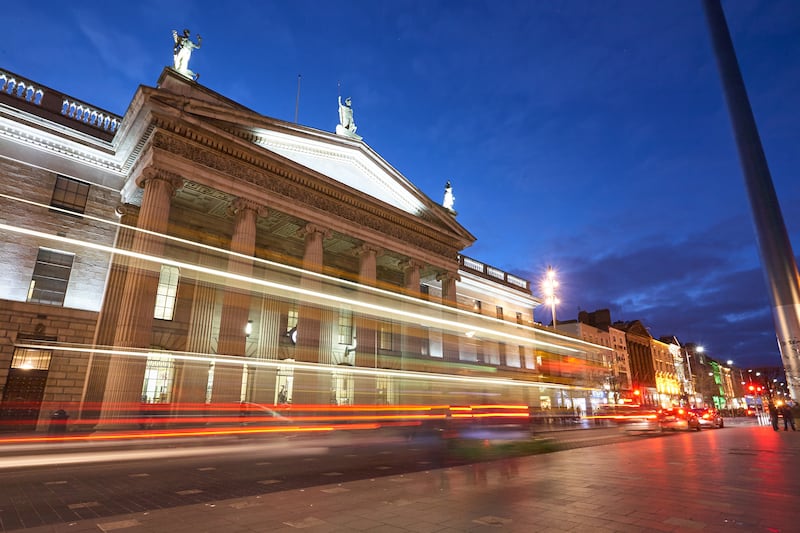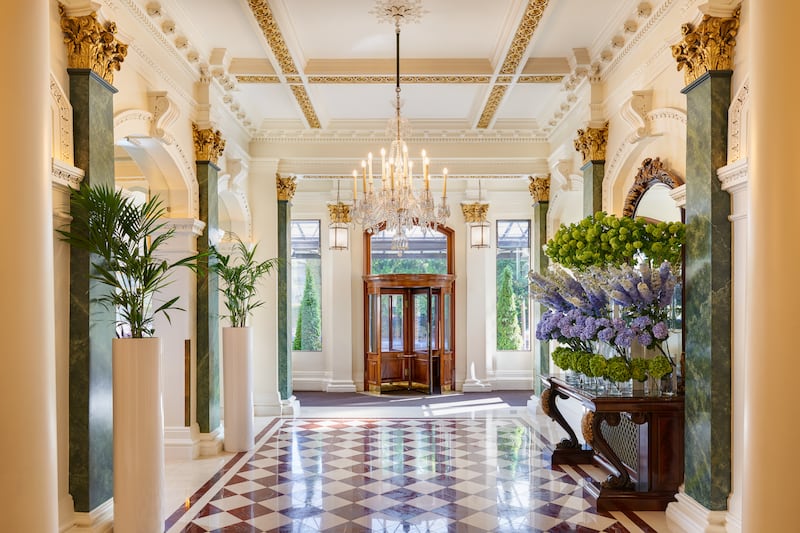While trying to navigate the pavement outside Trinity College on a summer’s day, you may have found yourself the poor unfortunate stuck behind a large group of tourists going nowhere fast.
Holidaymakers shuffling into the hallowed grounds to see the Book of Kells or the Long Room library can shave minutes off your precious lunch break.
On a recent battle to get to brunch, all heads were pointing upwards, as the guide was telling the assembled crowd about a statue that sits on top of the old Abercrombie and Fitch building on College Green. It depicts the goddess Éireann, who holds a harp, her trusty Irish wolfhound by her side.

She looks directly across at the royal coat of arms that is emblazoned on the Bank of Ireland building. If you’ve never noticed “Éire go Bragh” before, an easily overlooked statue that is the work of Edmund Sharpe and James Pearse, father of Padraig and Willie Pearse, you’re not alone.
READ MORE
In an effort to see the city through an international tourist’s eyes and learn a little more of your own history, a walking tour is a fun way to educate yourself about the capital.
There has been a huge uptick in walking tours since travellers began returning to our shores, guide Karl Deery (www.tourswithkarl.com) says. This particular jaunt starts at Dublin Castle, the highest point in the city centre.
There is no exact date for the founding of Dublin, with some saying 841AD for when the Vikings first landed on the east coast. However, the fact of four lampposts in the castle courtyard referring to the period from 988 to 1988 suggests differently. These mark Dublin’s celebration of the millennium in ‘88. “Really, it was just an excuse for a good party,” Deery jokes.
You are regaled with tales of Viking kings, Sigtrygg Silkbeard and Olaf the White. Fable is mixed with fact as you discover the ancient history of the area, as well as more recent events held in the Castle grounds – Panti Bliss addressing the crowd following the passing of the Marriage Referendum in 2015, or women hugging each other after their Repeal the Eighth campaign succeeded in 2018. And also, not to forget Queen Elizabeth’s historic visit to Ireland in 2011.

Dublin Castle has seen plenty of drama down through the years, including fires and expansions, all while it watched from above as the city grew. The Medieval Tower is one of the most intact buildings in Dublin for its age surviving today.
Built in the early 1200s, it was used as a wardrobe for royals, and later as a prison. Outside the Chapel Royal, next to the tower, are the stone heads of Brian Boru and St Patrick. According to legend, Boru heard the Banshee, the harbinger of death, the night before he was killed in battle.
In the 17th century, the crypt was used as a marketplace and a pub and now can be hired for private functions
On the tours, there is great interest in ghosts, ghouls, fairies and anything to do with the supernatural, Deery says.
In the Dubh Linn garden, the smell of cherry blossom fills the air in this oft forgotten part of the city, a lovely place to pop in to eat lunch on a sunny afternoon. The Silk Road Café in the Chester Beatty library does delicious food too.
Step outside the castle gates and attention is drawn towards a stone that marks the entrance to medieval Dublin. There are a number of these dotted around the city, and they mostly go unnoticed. Passing Burdocks, possibly the best fish and chips in Dublin, and the Lord Edward pub for a decent pint of plain, this walking tour crosses the road towards Christchurch Cathedral and the fascinating crypts that are nestled underground.

Some of the group are eager to see the mummified remains of a cat and rat, known locally as Tom and Jerry, that are reputed to have gotten stuck in an organ in the cathedral as one chased the other. In the 17th century, the crypt was used as a marketplace and a pub and now can be hired for private functions.
While not on the itinerary, a visit to St Michan’s Church near Arran Quay is recommended to the excited crowd, who would love to see the mummified remains of a 400-year-old nun and an 800-year-old crusader. This particular group really lap up the details of the macabre on offer.
Our guide gives a nod to Dublin humour as he draws attention to ‘the stiletto in the ghetto’, one of the many nicknames given to Dublin’s Spire
Next, into Wood Quay, where a significant Viking find was made in the 1970s, leading to an extensive excavation of the site before the controversial building in the 1980s of what are now the Dublin City Council offices. You’ll see pavement plaques indicating excavated items, several combs for example, suggesting the Vikings were more than fond of grooming their long luscious beards and locks.
In Temple Bar, Smock Alley theatre dates back to the 17th century and is a great place to catch a play. There are lots of independent clothes shops, restaurants and bars to visit too – not just the thronged pubs filled with stag and hen parties that the area has become synonymous with.
Scoot through Meeting House Square, where outdoor movies are shown in summer, and stop at the popular Wall of Fame. The crowd makes an attempt to name all of the artists depicted on the wall – sadly, we are all beaten by a music aficionado from Texas.

The final stop on this particular walking tour is the GPO, where there is great interest in the 1916 Rising and the foundation of the State.
Our guide gives a nod to Dublin humour as he draws attention to “the stiletto in the ghetto”, one of the many nicknames given to Dublin’s Spire, before being led back to Trinity College. As we part company, Deery explains the problem the Irish have with goodbyes. Nevertheless, he leaves us with a “Slán go fóil” – bye for now.
Stay

Just a stone’s throw from Grafton Street, the five-star Shelbourne Hotel, part of the Autograph Collection, is one of Dublin’s most luxurious places to rest your head. With the likes of JFK, the Ireland rugby team, Grace Kelly, Maureen O’Hara, Elizabeth Taylor, John Wayne, Laurel and Hardy, Charlie Chaplin and Paul Newman all calling it their home-from-home during stays in Dublin, you know you’re in good company in choosing this as your base for a stay in the capital.
Bagging a room to the front of the 1824-founded hotel allows you to wake up to stunning views over Saint Stephen’s Green, before taking in either a buffet or a la carte breakfast in the restaurant’s diningroom.
That same transforms into the Saddle Room for lunch and dinner, where you’ll be treated like a dignitary by friendly, attentive staff, while served a carefully crafted menu of old favourites. It’s fine dining, nestled in the inner sanctum of the hotel.
If in need of some body maintenance, the hotel has a relaxing spa, sauna, steam room, swimming pool and gym – perfect after a day of sightseeing or shopping.
The hotel also boasts three bars: people-watching hub No 27, and the more private Horseshoe and 1824 bars. The Lord Mayor’s Lounge transforms into the residents’ bar by night.
















